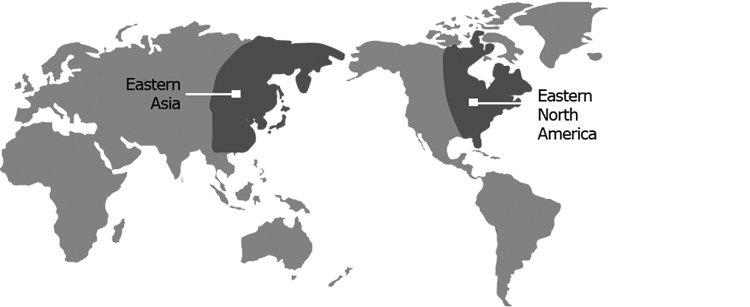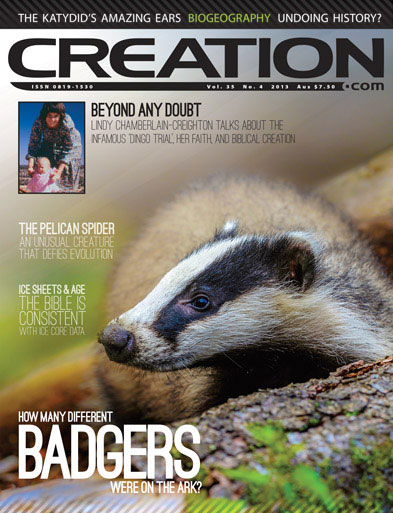No evidence of evolution and ‘deep time’
There are many similar plants and animals found in eastern Asia and eastern North America, but not in the regions between them (fig. 1). These include arachnids, millipedes, wasps, freshwater fish, and over 150 different seed plants.1,2 Evolutionists try to explain this by saying that, many millions of years ago, the northern regions were warmer and eastern Asia and eastern North America were part of one continuous plant and animal distribution (fig. 2). Then, they say, around five million years ago, the climate cooled and the plant and animal life were separated (fig. 1).3




Some plants and fungi found in eastern Asia and eastern North America are so similar that they are classified as being the same species.4,5 Others have been assigned different species names but probably should not have been. For example, the Snake Mouth Orchid is named Pogonia ophioglossoides when found in eastern North America, and Pogonia japonica when found in eastern Asia (fig. 3). When grown under the same conditions, however, they appear indistinguishable (fig. 4).
The Sacred Lotus (eastern Asia) and Yellow Lotus (eastern North America) are classified as two different species, Nelumbo nucifera and Nelumbo lutea (fig. 5).6 However, their hybrid form is fertile, again indicating that they are really the same species.7
The remarkable similarities between the plants and fungi of these two regions present a serious problem for evolutionists and their belief in ‘deep time’. This is because, over millions of years, sister species, living on different continents and separated by huge distances over land/ocean, would be expected to evolve different characteristics. According to the theory of evolution, the ancestors of humans separated from other ape-like creatures around six million years ago. Between then and now, the evolutionary process allegedly gave rise to all the many changes that turned these creatures into the people we are today. It is difficult for evolutionists to explain why, over the same time period, the plants and fungi of eastern Asia and eastern North America did not evolve and change too!

The similarities between the wildlife of these two regions, however, present no problem for biblical creationists. This is because, according to the Bible, none of the habitats found on the earth today can be older than around 4,500 years, the time of the global Flood, recorded in Genesis 6-8. It is possible that a continuous plant and animal distribution grew up linking eastern Asia and eastern North America due to the warm climate that existed at high latitudes directly after the Flood (fig. 2). This region may then have been split into two by the ensuing Ice Age and also the rising sea levels following its waning, around 800 years after the Flood.8


Credit: Dan Molter
References and notes
- Wen, J., Evolution of the eastern Asian and eastern North American disjunct distributions in flowering plants, Annual Review of Ecology and Systematics 30:421-455, 1999. Return to text.
- Quian, H., Foristic relationships between eastern Asia and North America: test of Gray’s hypothesis, The American Naturalist 160(3):317-332, 2002. Return to text.
- Xiang, Q. et al., Timing the Eastern Asian–Eastern North American Floristic Disjunction: Molecular Clock Corroborates Paleontological Estimates, Molecular Phylogenetics and Evolution 15(3):462–472, 2000; cals.ncsu.edu/plantbiology/Faculty/xiang/Xianglab/www/Papers/XiangSoltis2000.pdf. Return to text.
- Ref. 2, p. 318. Return to text.
- Hongo, T. And Yokoyama, K., Mycofloristic ties of Japan to the continents, Memoirs of the Faculty of Education of Shiga University 28:75-80, 1978; libdspace.biwako.shiga-u.ac.jp/dspace/bitstream/10441/3581/2/SJ07_0028_076A.pdf. Return to text.
- botit.botany.wisc.edu/courses/systematics/family_index/Family_Pages/Family_N_O/Nelumbonaceae.html. Return to text.
- Xue, J. et al., Polymorphic chloroplast microsatellite loci in Nelumbo (Nelumbonaceae), American Journal of Botany e240-e244, 2012. Return to text.
- See Batten, D., ed., The Creation Answers Book, Creation Book Publishers, Queensland, Australia, ch. 16, 2009; https://dl0.creation.com/articles/p075/c07550/chapter16.pdf. Return to text.






Readers’ comments
Comments are automatically closed 14 days after publication.